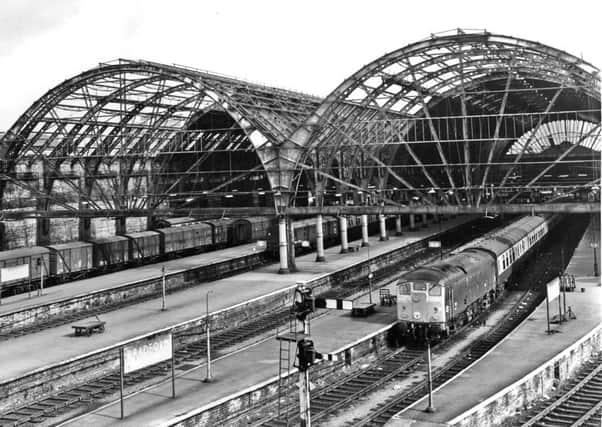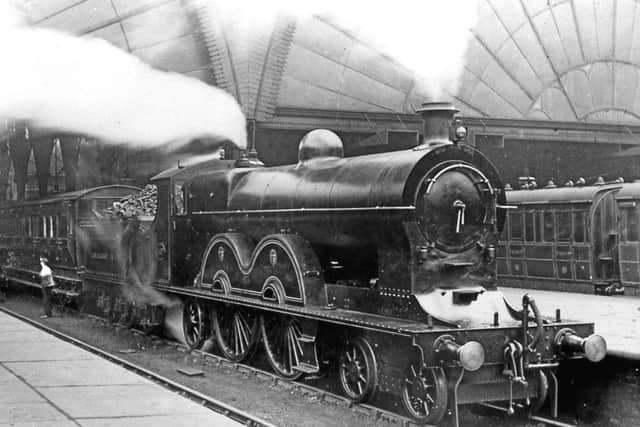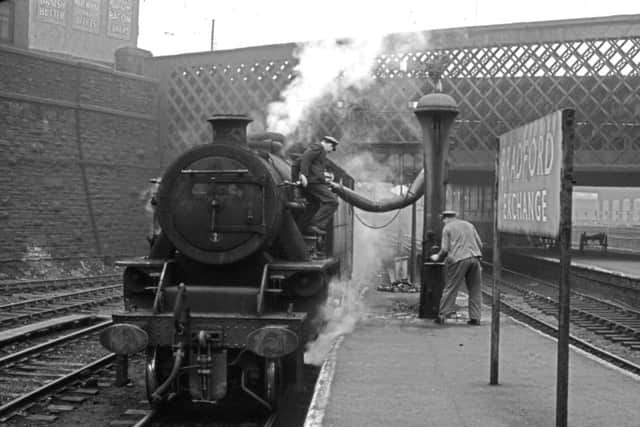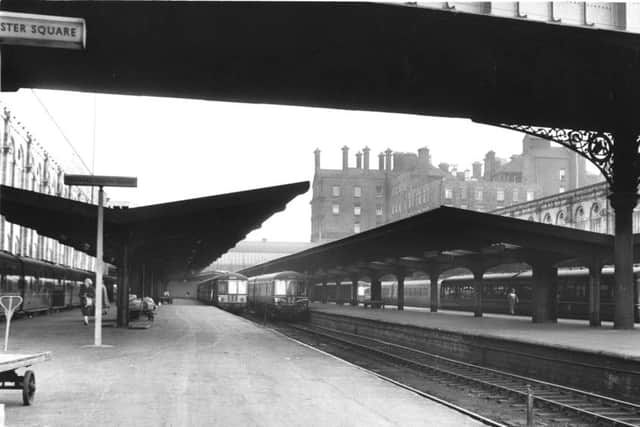Station to station


All this has occurred over a 173-year period. In the heady days of Victorian railway progress, Bradford’s first station, was probably initially titled just Bradford, but became known as Market Street. An imposing neo-classical structure, it was designed by William Andrews and opened, by the Leeds & Bradford Railway, on June 30, 1846 – the same day as the opening of the line between the two cities. The engineer in charge of the project was George Stephenson. At the outset there were hourly services to Leeds Wellington station and through trains to London via Derby and Rugby.
On the opening day festivities, a pavilion was erected to serve around 400 with a sumptuous lunch. The food provided included 20 joints of beef, 36 pigeon pies, 24 hams, 20 lambs, 54 ducks, 60 chickens, 140 dishes of sweets, 12 dishes of pickled salmon, 30 jars of potted meat, 24 tongues, 40 lobsters and 60 dishes of fruits.
Advertisement
Hide AdAdvertisement
Hide AdBradford Exchange station on the south side of Hall Ings was opened on May 9, 1850 by the joint efforts of the Lancashire & Yorkshire/Great Northern Railway. A newspaper report described it as neat and commodious, saying: “The station is central and surrounded by extensive warehouses and manufactories, with convenient approaches from Leeds Road and Bridge Street. The platform is covered with a shed, 120 yards long and 63 feet span. If we were disposed to be critical, we should say that it is somewhat low and has a deficiency of glass.” The architect of the Italianate-style building was Eli Milnes of Bradford.


The 1850s saw other significant railway developments in Bradford. The Leeds & Bradford Railway company was absorbed by the Midland Railway in 1851 and the new owners of the Market Street station, according to George Sheeran in Railway Buildings of West Yorkshire 1812-1920 (1994), altered the building “out of all recognition around 1853”. The author also adds that the remodelled station, although a pleasant enough palazio-derived design, “lacked the tightness and vigour of the earlier Andrews station”.
Bradford Adolphus Street station, on the south side of the junction of Dryden Street and Wakefield Road, was the town’s third railway station, and opened by the Leeds, Bradford & Halifax Junction Railway on August 1, 1854. Contemporary newspaper reports state the station was not completed at the time of the opening of the company’s new “short line” between Bradford and Leeds. But it was intended to be a very large and commodious one. One report said: “Not fewer than ten acres of land are set apart as the site for the projected station. A neat, commodious booking office, in the modern Italian style of architecture, is fast rising from the ground in Adolphus Street. The platform of the station will be covered by a roof which will be one hundred feet in span and rising fifty feet above the level of the platform. It will form the finest roof in this locality, something equal to the roof at the Great Northern station at King’s Cross, except that this roof will have iron girders not timber.”
Although much effort had gone into establishing Adolphus Street station, it was inconveniently situated – further out of the town centre than Market Street and Exchange stations. Thus, the station was closed to passengers on January 7, 1867 and GNR trains were transferred to Exchange station. Adolphus Street station remained in use for goods traffic until the goods yard closed on May 1, 1972.
Advertisement
Hide AdAdvertisement
Hide AdExchange station, unable to cope with the vast increases in passenger traffic, was rebuilt on the same site during the 1880s. One newspaper said of the design “externally it is not such an acquisition to the architectural features of the town”. This was due mainly to its peculiar situation, as on the northern side it was bounded by some of the best warehouse property in the town which concealed it from view. The main station building was described as consisting of two spans of arches (each 100ft). The space within one arch was reserved for Great Northern Railway Company traffic and the other for the Lancashire & Yorkshire Company. The roofs were of iron and glass; four end screens were glazed in a fan pattern. The entire station was described as “cheerful in aspect, as well as light and airy”.


The Market Street station was rebuilt by the Midland Railway Company in 1890 and opened on March 2, that year. Absorbed in the work were all the buildings which formerly stood between the old station and Cheapside as far as School Street – a quarter of the city which was known as “Bermondsey”.
Both the station and hotel adjoining were designed in a style described “as a practical adaption of the Italian Renaissance” by architect Charles Trubshaw. Occupying one side of Forster Square, the new station formed a continuation of Kirkgate from Cheapside to Canal Road, the facade being around 300ft.
From 1924 Market Street station was renamed Forster Square station and in time the station was much altered with the overall roof being replaced by individual canopies over the platforms. From 1990, a new station was in operation on the western side of the former station which was later demolished.
Advertisement
Hide AdAdvertisement
Hide AdMuch of the Adolphus Street station goods yard had been demolished by 1970.


Exchange station closed on January 13, 1973. On the following day, a smaller station was opened nearby as part of the new Transport Interchange for trains and buses. Whilst the new station is more suitable for today’s needs, it cannot compare with the former station’s architectural splendour.